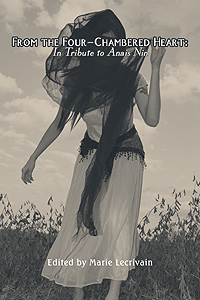Review of FROM THE FOUR-CHAMBERED HEART: IN TRIBUTE TO ANAIS NIN
From the Four-Chambered Heart: In Tribute to Anais Nin
published by Sybaritic Press, 2013
learn more and order
Having heard and been disappointed by my share of tribute music albums, I often approach tribute literature with a grain of salt in one hand and keep the other hand free just in case I have to yawn. Maybe this attitude stems from my lifelong indifference to dressing up for Halloween, and emulous songs or writings seem like costumes rather than unique ensembles.
Now that I’ve bashed the nature of the very thing I’m endorsing, I’m pleased to say that From the Four-Chambered Heart impressed rather than underwhelmed me. First of all, the honoree is ultra-interesting, and editor Marie Lecrivain should be praised for even thinking of and braving the concept.
Despite her popularity among artistic circles, Nin still seems to be a fringe writer. As Lecrivain says in Four-Chambered’s introduction, she’s “not for the faint of heart.” Her harsh polarities, her careless sexuality, her incestuous abandon and her clever perversity aren’t standard fare for readers at large, and, paradoxically, many artistic folks probably worry about digging her for being popular among artistic circles. The latter are in error, however, because Nin lives up to much of the hype (though I appreciate her for her turbulent persona more than her actual work).
Nin is most famous for her infamous diary, which is responsible for her best-known work of fiction, Henry and June (which chronicles the inexplicable sex triangle that included the slovenly satyr Henry Miller and his Sphinxy wife June). Even the most bizarre stories in Nin’s erotica could pass as her own sexploits, or at least searing fantasies put to paper. I say this because burns happen when fire is played with, so compiling poetry and prose based on, inspired by and emulous of such a passionate minx as Nin is not exactly risk-free. After all, as the editor of this collection bluntly conjectures, her work can be considered to be that of a sociopath.
It’s interesting to see how this controversial woman and author has inspired and influenced different folks. One might expect much of a Nin-honoring collection to be a field day for vesuvian sexuality and literary smut, but not every piece in Four-Chambered plunges very far into the cessier pools of Nin’s libido. In fact, there’s a surprising lot of PG-rated stuff. One of the several exceptions is “Perspectives Across a Dinner Table,” a prose piece written by D.L. Warner, erotica-leaning author and filmmaker (and co-dedicatee of the book). Two fiction examples are presented: an explicit scene of two lovers exchanging oral sex before having an omelet, and an explicit excerpt from Thomas Harris’s Hannibal, in which the title character sautees sliced human brain while the lobotomized victim (the top of his skull having been removed) sings and babbles stupidly. The point? That the former is not as readily accepted as the latter, including by many religious folks. Warner questions Nin for reducing her wonderfully composed erotica to money-making potboiling, and credits the author for inspiring her own serious erotica. I’m with Warner. Delta of Venus and Little Birds, regardless of some of the taboo transgressions, are delightfully written and worthy of the name literature.
I’m a sucker and a stickler for titles, so many of the ones in this collection pleased me: “Anais Nin Waves by the Waves,” “My Soul as Jaguar,” “Blonde in a Red Tunnel,” “Nin and Kafka Drinking Absinthe” and “Fever 2012,” to name some. And my favorite pieces include Ruth Nolan’s “Forbidden Fruit,” M. Justine Gerard’s dripping “Anni and the Order of Perfectibilis” (rating: five fingers up!), John FitzGerald’s “Five,” Marie Lecrivain’s “My Soul as Jaguar” and Pam Ward’s “Anais’s Husband.”
The book also features black-and-white photography (some of it done by the editor herself), which helps complement a vibe and showcases work in another art medium. My favorite photograph (by Aunia Kahn) is used as the front-cover image: a woman who is meant to pass for Nin without revealing the face. This seems to serve a dual-purpose: to hide the model’s identity, and to allow the selected writers to fill in Nin’s face, so to speak. Or, perhaps, it illustrates the fundamental obscurity of a person we admire and think we know so much.
review by David Herrle, December 2013

